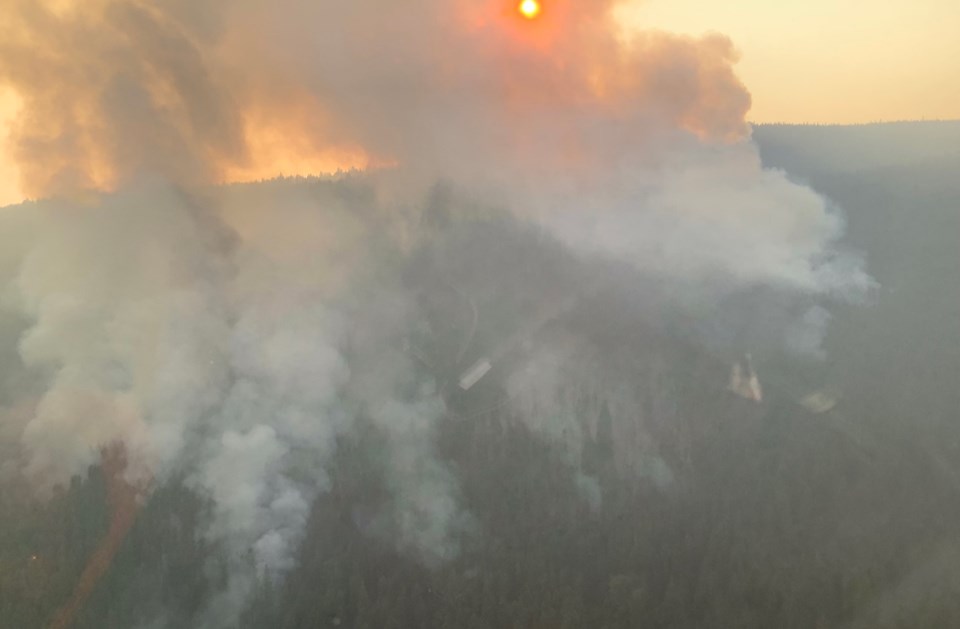Summer 2023’s record Interior blazes are serving as a reminder about the need to spend more to prevent and mitigate wildfires.
But the province must also rethink its methods, according to a June report by an independent government and industry watchdog.
“Wildfire risk reduction or restoration treatments can be costly, and there is currently little funding to support landscape treatment outside the wildland urban interface,” said the Forest and Fire Management in B.C. report from the Forest Practices Board (FPB). “The cost of treatments is a significant barrier. Without large and sustained financial support, markets for the residual fibre, or imposing legal requirements, risk reduction or restoration treatments will not occur.”
Landscape fire management, the report said, recognizes the role of fire in the ecosystem, but “embraces ecologically appropriate fuel management tools, including managed wildfire, prescribed burning, creation of fuel breaks and stand-level fuel treatments.”
The report notes the changing climate means longer fire seasons with a higher risk of ignitions and more areas severely burned. Wildland-urban interface (wherever human development begins mixing with nature) is the government’s focus. While “well-intentioned”, little has been done to reduce the broader risk of wildfire.
Over 96.3 million acres of B.C. public land are at high or extreme risk for wildfires. Only 64,000 acres – or one per cent of the wildland-urban interface – have been treated since 2018, coming in at a cost of $72 million.
“If the people of B.C. want to co-exist with fire, there is an urgent need to act now at a pace and scale that will achieve landscape resilience,” the report said.
Meanwhile, south of the border, the Biden administration has already turned its attention toward landscape fire management. The 10-year Wildfire Crisis Strategy is part of an US$8.25-billion program to treat 20 million more acres of national forests and grasslands, and support another 30 million acres of federal, state, tribal, private and family lands.
FPB has been calling for change for years. In 2017, then-chair Tim Ryan compared B.C.’s $200 million average annual expenditure on fighting wildfires with the $60 million spent on wildfire prevention between 2005 and 2015.
The year 2017 was also significant for the 10-week state of emergency that saw $568 million spent on fighting fires and 65,000 people displaced. It was also the summer that the BC NDP minority government under John Horgan came to power.
Former BC Liberal cabinet minister George Abbott and Sto:lo Chief Maureen Chapman were hired to produce the Addressing the New Normal: 21st Century Disaster Management in British Columbia report on fires and floods.
Abbott and Chapman called for local governments to play a bigger role, but acknowledged that they are already focused on spending on building and maintaining water, sewer, roads, streetlights, parks and recreation and solid waste infrastructure. They recommended focusing on landscape-level treatments, prescribed burning and “a comprehensive strategic plan identifying communities at greatest risk from wildfire.” But they acknowledged the growing gap between spending on response versus planning/preparing/preventing/mitigating.
“If we are to limit the vulnerability of our homes, our properties and our communities to such extreme weather events and the new normal, the time to reinvest is now,” the 2018 report said.
A government follow-up report in late 2019 found that the province and feds had adopted the Sendai Framework for Disaster Risk Reduction with the goal of strengthening “each pillar of emergency management, through all-of-society efforts.”
The four-step plan calls on governments to understand disaster risks, strengthening governance to better manage those risks, invest in risk reduction and enhance preparedness to respond effectively and “build back better.”
When the pandemic came a few months after the report, “build back better” became a popular catchphrase among international political leaders. Residents of Lytton, B.C., who saw their town go up in smoke in June 2021, are waiting to find out what that really means.
That 2019 report also contemplated an overhaul of B.C.’s Emergency Program Act. The province had intended on tabling it during the fall 2020 legislative session. However, in the middle of the pandemic’s first year, Horgan called a snap election and the amendments were delayed.
The new law was delayed again by the heat dome disaster in June/July 2021 and the torrential rains and floods in November 2021.





